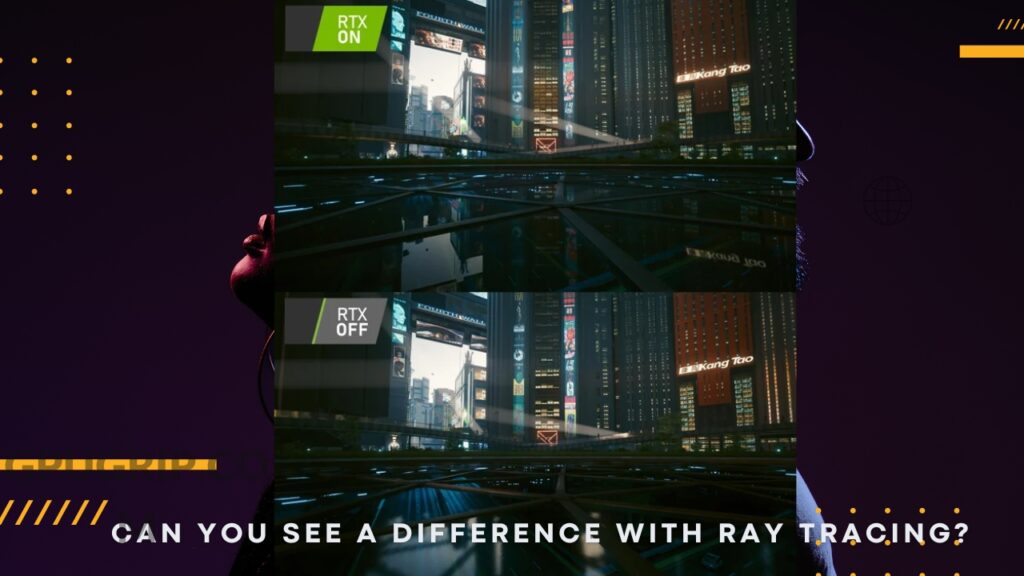Quick Navigation
Do you remember when you first heard the word “Ray Tracing?” I’m sure not, but it’s been around the corner for a long now. With the horizon of NVIDIAs’ Turing architecture, there was a dawn of a new in-graphic feature, Ray tracing. At the same time, leveraging light sources in the game, the ray tracing improved graphics significantly.
Although Ray tracing was and still is among the best features but was used mainly by high-end gamers and professionals. Despite making a stir in the market, the RTX graphics card needed to be in the range of both budget and PC support for most gamers. And if some hardcore gamer wished to upgrade to Ray Tracing PC, they must make a hole through the pocket to get this powerhouse.
Despite providing a graphical edge in games, Ray tracing is a hot debate among gamers as some agree that it is worth it, and some say it lags the FPS far behind in improving the graphics. So is ray tracing worth it since it is a pricey investment?
This article will discuss the gives and takes of using ray tracing in gaming and explore the technology behind it. We will also examine the cost of ray tracing-supported graphics cards and whether it’s worth the investment.
What Does Ray Tracing Actually Do?

Simply put, Ray tracing is the ability to put shadows in Graphics. I’m sure you low Pixar movies, but why do you love them? I’m sure it’s their strong storylines, but the major contributing factor is graphics, particularly ray tracing.
Ray tracing renders the light from the nearest light source and will calculate if the light will reflect, bounce back, absorb into the object, or be motion blur. Result? Incredibly life-like graphics. Intelligent right?
Now what good does it do for gaming? Traditional rendering techniques leverage rasterization, which merely puts estimates on lights and shadows. However, on the other hand, ray tracing puts life into the physical objects in a game since it traces light and provides a more accurate rendering for life-like gaming.
Regarding RTX or Real-time ray tracing, it does all the light and shadow calculations within a fraction of milliseconds in real-time, providing prompt responses to gamers.
But since the RTX does it in real-time, it will surely need powerful hardware or a dedicated RTX GPU. On the other hand, you don’t need a powerhouse of hardware for offline ray tracing, as it will do that for a long time.
Pros and Cons of Ray Tracing
There are a lot of gives and takes of the Ray tracing.
One significant benefit of it is that it offers super realistic graphics. Remember what we said about Pixar movies? Ray tracing offers the same graphics in games. Moreover, you enjoy VR-ready immersive gameplay with improved realism and lighting effect.
Some users say RTX is overrated and does not make a huge difference; instead, it makes for a lower FPS than regular gameplay. But the dynamic lighting of RTX makes a distinction in immersion. VR games are more likely to offer an out-worldly experience.
But wait, there is more to this tech. The RT is not supported by much hardware, and you need to invest big for your PC to run it. And the fact that RT is still in its infancy (at least for gaming), it will take a while to become an industry standard for gaming. Still, there are a lot of mid-range GPUs that offer RT.
Remember, the RT does offer exceptional graphics for games like Hellblade, Minecraft, Quake 2 Cyperpunk, and Metro Exodus, but it does have compatibility issues with older games and hardware. As we said, it will take some time to become a standard, and for now, you have to get appropriate games and hardware to enjoy immersive gameplay.
Can You See a Difference with Ray Tracing?

As previously stated, ray tracing creates a lifelike visual by following a light source’s path. Not only that, but it further selects the precise color based on how the light reflects off the object. So in layperson’s terms, the RT considers three things: the path that light takes from the light source to the object, the camera view, and other objects in the room.
Result? Ray tracing offers impressive graphics, as you can see above. But whether to get an RTX GPU boils down to individual preferences. Some want better graphics above anything, while better FPS is everything for some users.
For instance, you can play cyberpunk at 60 FPS with RTX ON and at 90 FPS when it’s off. So, which one will you choose, better FPS or better graphics? Off course, better graphics if you are playing something other than AAA titles. You should weigh your gaming needs and demands before upgrading to RT GPU.
Ray Tracing Vs. Rasterization
Now the question is, what technique was in before RT? Rasterization is the art of converting 3D to 2D and then shaders making an educated guess of its color and shadow effects on aesthetics.
As mentioned above, the rasterization technique guesses the color gradient and shading, which is why its graphics are not impressive. This technique has existed since 1960, but even starter-level NVIDIA GPUs can do outstanding graphics with rasterization. However, it is far behind the RT as it works on photons and how the object, light source, and angle will affect the shadows.
While these graphics work wonders for movies, they will extract every bit of power for games. Some users say they will leave half of the FPS for the game, even for the essential RATE factor.
How Expensive is Ray Tracing Supported Graphics Cards?
RT cards might not have been abundant in the market a few years ago, but they are now widely available. Some older GPUs, like GTX 1000’s GPU, also offer RT with a huge in-game performance difference. However, those GPUs compromise on the multiplayer scenario games, but for single-player titles, they are good.
If you opt for the GTX models (not RTX), they might make you break the bank as they cost around 500-700 bucks. If you already have an RT-supporting PC but want a GPU, you can think of this worthy purchase.
Furthermore, if you use the dedicated RTX GPUs for ray tracing, spend over 1000 bucks. The RTX 3000s series is much more pricey than only professional gamers might want to opt for it. And if you ask about their availability, they are abundant, so if you have cash in your pocket, you can get it from anywhere.
You may Also Like: Best Budget Graphics Card
Can you ray trace in 1080p?
An important factor with the RT is that it does not care about the resolution you play games on. Instead, it depends on if your console developer has enabled the RT feature. And if your GPU has the RT factor. While you can go for the RT at 1080 resolution for most modern titles like CoD and Cyperpunk but the FPS will be reduced significantly.
Does ray tracing reduce FPS?
RT certainly makes your games lag behind, as they require enormous processing power. Although you can depend on RT for better graphics and hyper-realistic gameplay, there are also mixed opinions. Some users complement it for games like CoD, Cyperpunk, Exodus, and Quack, as it offers impressive building reflections and on-ground graphics.
On the other hand, some users say that it makes gameplay a disaster. But it all boils down to how objects are designed in the game and the implementation of the ray tracing element.
Do You Really Need Ray Tracing?
Not really, if the graphics are unimportant and you want better frame rates. All the fancy features of the RT will need more processing power than the GPU, so chances are you might not achieve higher frame rates as you will with the RT off.
Moreover, Ray Tracing is best suited for those who play titles with impressive backgrounds and scenery, as it puts soul into the gameplay. However, if you prefer simple single-player titles or graphically simple titles, RT is not a good shot as the difference will barely be noticeable.
Can GTX do ray tracing?
Yes, GTX can trace the ray, but here is a catch. It will not go toe to toe with your in-game performance. You can only juice out the primary RT effects, not advanced and sophisticated ones, with the GTX since they have a low ray count. On the other hand, even the starter model of the RTX line will make for amazing graphics with better FPS and in-game performance as they have a higher ray count.
Pro Tips

By now, you might be interested in trying the RT on your favorite title, but if you plan to do so, here are some tips to consider:
- Since you will be investing a considerable sum into RT-enabled GPUs, you must consider your gaming needs and preferences before investing in ray-tracing technology.
- You should also be mindful of your CPU and other hardware and how the RT will impact your hardware requirements and performance. If you have an old-generation CPU, the RT might not be the best match, as it will lead to a bottleneck.
- You should also thoroughly research games with ray tracing support to determine if it’s worth the investment. Moreover, it can run your favorite titles.
- If you truly indulge in RT GPU and desperately want an RT setup, wait for sales or deals to save money. Moreover, you should also stay informed on advancements in ray tracing technology and its growing support in the gaming industry.
Conclusion
The ray tracing, worth it or not, depends on you and your game demands. It is worth considering if in-game graphics are everything for you and you have money and RT-supporting hardware down the hand. You will enjoy better visuals but with reduced FPS (thanks to extra graphic processing).
And yes, what if your favorite title does not support it? It will be a waste. We recommend waiting until you see the RT factor in affordable mid-range GPUs.

